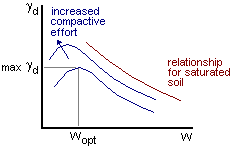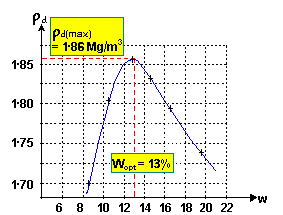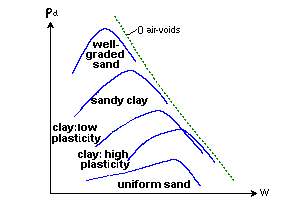
by Prof. John Atkinson, City University, London
 |
Based on part
of the GeotechniCAL
reference package by Prof. John Atkinson, City University, London |
| Back to Soil Mechanics |

Compaction is a process that brings about an increase in soil density or unit weight, accompanied by a decrease in air volume. There is usually no change in water content. The degree of compaction is measured by dry unit weight and depends on the water content and compactive effort (weight of hammer, number of impacts, weight of roller, number of passes). For a given compactive effort, the maximum dry unit weight occurs at an optimum water content. |  |
Compaction is a process of increasing soil density and removing air, usually by mechanical means. The size of the individual soil particles does not change, neither is water removed.
Purposeful compaction is intended to improve the strength and stiffness of soil. Consequential (or accidental) compaction, and thus settlement, can occur due to vibration (piling, traffic, etc.) or self-weight of loose fill.
Compaction purposes and processes
Compaction is employed in the construction of road bases, runways, earth dams, embankments and reinforced earth walls. In some cases, compaction may be used to prepare a level surface for building construction.
Soil is placed in layers, typically 75 mm to 450 mm thick. Each layer is compacted to a specified standard using rollers, vibrators or rammers.
Refer also to Types of compaction plant and Specification and quality control
Compaction purposes and processes
Compaction can be applied to improve the properties of an existing soil or in the process of placing fill. The main objectives are to:
Compaction purposes and processes
A number of factors will affect the degree of compaction that can be achieved:
Compaction purposes and processes
Construction traffic, especially caterpillar-tracked vehicles, is also used.
In the UK. further information can be obtained from the Department of Transport and handbooks on civil engineering construction methods.
 Smooth-wheeled roller
Smooth-wheeled roller
 Sheepsfoot roller
Sheepsfoot roller
 Pneumatic-tyred roller
Pneumatic-tyred roller
 Vibrating plate
Vibrating plate
 Laboratory compaction tests
Laboratory compaction testsThe variation in compaction with water content and compactive effort is first established in the laboratory. Target values are then specified for the dry density and/or air-voids content to be achieved on site.

The aim of the test is to establish the maximum dry density that may be attained for a given soil with a standard amount of compactive effort. When a series of samples of a soil are compacted at different water content the plot usually shows a distinct peak.
Dry-density/water-content relationship
For clays
Recently excavated and generally saturated lumps of clayey soil
have a relatively high undrained shear strength at low water contents and are difficult to compact. As
water content increases, the lumps weaken and soften and maybe compacted more easily.
For coarse soils
The
material is unsaturated and derives strength from suction in pore water which collects
at grain contacts. As the water content increases, suctions, and hence effective stresses decrease. The soil weaken,
and is therefore more easily compacted.
For both
At relatively
high water contents, the compacted soil is nearly saturated (nearly all
of the air has been removed) and so the compactive effort is in effect applying undrained loading
and so the void volume does not decrease; as the water content increases the compacted density
achieved will decrease, with the air content remaining almost constant.
Dry-density/water-content relationship
 Expressions for calculating density
Expressions for calculating density

A compacted soil sample has been weighed with the following results:
Mass = 1821 g Volume = 950 ml Water content = 9.2%
Determine the bulk and dry densities.
Bulk density r = 1821 / 950 = 1.917 g/ml or Mg/m³
Dry density rd = 1.917 / (1+0.092) = 1.754 Mg/m³

A fully saturated soil has zero air content. In practice, even quite wet soil will have a small air content

The maximum dry density is controlled by both the water content and the air-voids content. Curves for different air-voids contents can be added to the rd / w plot using this expression:

The air-voids content corresponding to the maximum dry density and optimum water content can be read off the rd/w plot or calculated from the expression (see the worked example).
Determine the dry densities of a compacted soil sample at a water content of 12%, with air-voids contents of zero, 5% and 10%. (Gs = 2.68).

 Effect of increased compactive effort
Effect of increased compactive effortThe compactive effort will be greater when using a heavier roller on site or a heavier rammer in the laboratory. With greater compactive effort:
 Effect of soil type
Effect of soil type
Firstly, the densities are calculated (rd) for samples with different values of water content, then rd / w curve is plotted together with the air-voids curves.
The maximum dry density and optimum water content are read off the plot.
The air content at the optimum water content is either read off or calculated.
Interpretation of laboratory data
In a typical compaction test the following data might have been collected:
Mass of mould, Mo = 1082 g
Volume of mould, V = 950 ml
Specific gravity of soil grains, Gs = 2.70
| Mass of mould + soil (g) | 2833 | 2979 | 3080 | 3092 | 3064 | 3027 |
| Water content (%) | 8.41 | 10.62 | 12.88 | 14.41 | 16.59 | 18.62 |
For method of determining water contents see Soil Description and Classification
Interpretation of laboratory data
The expressions used are:

| Bulk density, r (Mg/m³) | 1.84 | 2.00 | 2.10 | 2.12 | 2.09 | 2.05 |
| Water content, w | 0.084 | 0.106 | 0.129 | 0.144 | 0.166 | 0.186 |
|
Dry density, rd (Mg/m³) |
1.70 | 1.81 | 1.86 | 1.851 | 1.79 | 1.73 |

Interpretation of laboratory data
The expression used is:

| Water content (%) | 10 | 12 | 14 | 16 | 18 | 20 |
| rd when Av = 0% | 2.13 | 2.04 | 1.96 | 1.89 | 1.82 | 1.75 |
| rd when Av = 5% | 2.02 | 1.94 | 1.86 | 1.79 | 1.73 | 1.67 |
| rd when Av = 10% | 1.91 | 1.84 | 1.76 | 1.70 | 1.64 | 1.58 |

The optimum air-voids content is the value corresponding to the maximum dry density (1.86 Mg/m³) and optimum water content (12.9%).

The degree of compaction achievable on site depends mainly on:
Specification and quality control
Target parameters are specified based on laboratory test results:

Optimum water content working range, i.e. ± 2%
Optimum air-voids content tolerance, i.e. ± 1.5%
For soils wetter than wopt, the target Av can be used, e.g.
10% for bulk earthworks
5% for important work
The end-result method is unsuitable for very wet or variable conditions.
Specification and quality control
A site procedure is specified giving:
This is a procedure developed by the Road Research Laboratory using only one sample, thus making laboratory compaction testing quicker and simpler. The minimum compactive effort to produce near-full compaction is determined. Soil placed in a mould is compacted by blows from a rammer dropping 250 mm; the penetration after each blow is measured.

After plotting Dp against the number of blows n, a line is drawn through the steepest part.
The intercept of this line and the 5 mm penetration line give the MCV
The defining equation is:MCV = 10 log B
(where B = number of blows corresponding to 5 mm penetration)
On the example plot here an MCV of 13 is indicated.
The MCV test is rapid and gives reproducible results which correlate well with engineering properties. The relationship between MCV and water content for a soil is near to a straight line, except for heavily overconsolidated clays.A desired value of undrained strength or compressibility can be related to limiting water content, and so the MCV can be used as a control value after calibrating MCV vs w for the soil. An approximate correlation between MCV and undrained shear strength has been suggested by Parsons (1981).
Log su = 0.75 + 0.11(MCV)
![]()